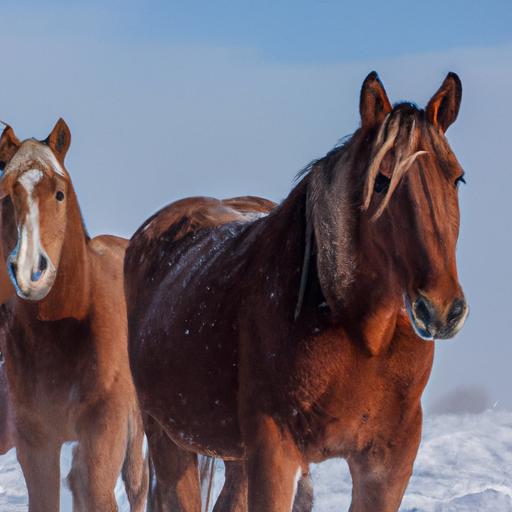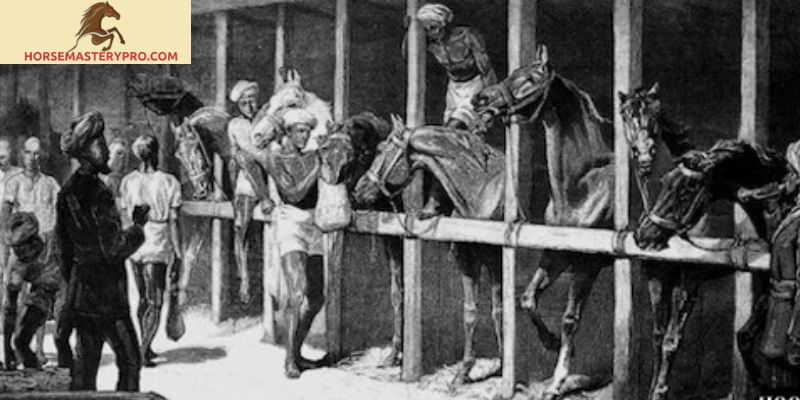Unlock the mysteries behind the process of horse latitudes! Explore the atmospheric conditions and the impact of high-pressure systems on wind patterns in these enigmatic regions.
Have you ever wondered about the enigmatic phenomenon known as horse latitudes? These intriguing regions hold a significant place in both geography and history, captivating the minds of explorers and scholars alike. In this article, let’s embark on a fascinating journey to uncover the process behind horse latitudes and explore their profound impact on our world.
Horse latitudes refer to specific latitudinal zones characterized by calm, windless conditions and high atmospheric pressure. These regions are situated at approximately 30 degrees north and south of the equator, encompassing parts of the Atlantic and Pacific Oceans. But how did these peculiar latitudes earn such a peculiar name?
Steeped in maritime history, the term “horse latitudes” finds its origin in the era of sailing ships. Picture a time when sailors relied solely on the power of the wind to navigate the vast oceans. As they ventured closer to the 30-degree mark, they often encountered stagnant air and still waters, leaving their ships becalmed for extended periods. In these challenging conditions, sailors would sometimes be forced to jettison horses overboard to conserve limited water and food supplies, hence the name “horse latitudes.”
Today, we understand that horse latitudes are a consequence of complex atmospheric processes. The interaction between the Hadley cell and the Ferrel cell plays a crucial role in their formation. In these latitudes, air masses from the tropics descend towards the Earth’s surface, creating high-pressure systems. These systems inhibit the formation of strong winds, leading to the calm and windless conditions synonymous with horse latitudes.
Join me as we delve deeper into the factors influencing horse latitudes and their far-reaching consequences. In the upcoming sections, we will unravel the intricate details of this atmospheric phenomenon and its impacts on climate, agriculture, trade routes, and human settlements. Prepare to broaden your knowledge and gain a deeper appreciation for the intricacies of our planet’s dynamic systems.
So, fasten your seatbelts and get ready to embark on an enlightening expedition into the captivating world of horse latitudes. Together, we will unlock the secrets of these fascinating regions and expand our understanding of the complex processes that shape our planet’s geography and history.
Understanding Horse Latitudes

Defining Horse Latitudes: A Geographical Phenomenon
To truly grasp the essence of horse latitudes, let’s start by defining this intriguing geographical phenomenon. Horse latitudes refer to the regions located around 30 degrees north and south of the equator, where sailors historically encountered calm and windless conditions. These zones span parts of the Atlantic and Pacific Oceans, captivating the attention of explorers and scientists alike.
Unraveling the Historical Origins
The term “horse latitudes” carries a rich history intertwined with the world of sailing. As sailors embarked on daring voyages across the vast oceans, they encountered these peculiar latitudes, often finding themselves trapped in still waters with little to no wind. The origin of the name itself stems from a rather somber practice that sailors resorted to during these challenging times.
In the age of sailing ships, water and food supplies were limited, leaving sailors stranded for days or even weeks in the horse latitudes. To preserve precious resources, sailors would sometimes make the heart-wrenching decision to jettison their horses overboard. This drastic measure ensured the survival of the crew and other essential supplies, but it also gave these latitudes their peculiar name.
The Interplay with Sailing
The connection between horse latitudes and sailing extends beyond their historical naming. Sailors heavily relied on the wind for propulsion during their journeys. As they approached the 30-degree mark, they often encountered an abrupt shift in wind patterns, with the once steady trade winds weakening or even vanishing altogether. These windless conditions posed significant challenges to sailors, who found themselves becalmed and unable to progress.
The historical significance of horse latitudes in sailing cannot be overstated. These regions tested the ingenuity and resilience of seafarers, forcing them to explore alternative methods of propulsion, such as utilizing oars or waiting patiently for favorable winds to resume their voyages.
Now that we have a better understanding of the geographical location of horse latitudes and their historical ties to sailing, let’s delve deeper into the factors that contribute to the unique characteristics of these intriguing regions. Join me in the next section as we explore the intricate processes that shape horse latitudes and their impact on our planet’s weather systems.
Factors Influencing Horse Latitudes

Exploring the Atmospheric Conditions
To comprehend the formation of horse latitudes, it is crucial to grasp the underlying atmospheric conditions at play. These conditions are instrumental in creating the unique characteristics of these latitudinal zones.
In horse latitudes, a key factor is the presence of high-pressure systems. These systems arise due to the descending air masses from the tropics, specifically from the subtropical high-pressure belts. As the air descends towards the Earth’s surface, it undergoes compression, leading to an increase in temperature and a subsequent rise in atmospheric pressure. The resulting high-pressure systems create a region of stable atmospheric conditions.
Unraveling the Impact on Wind Patterns
The presence of high-pressure systems in horse latitudes has a significant impact on wind patterns. Due to the descending air masses and the resulting high pressure, the air becomes less conducive to vertical movement and convection, inhibiting the formation of strong winds. This phenomenon gives rise to the calm, windless conditions characteristic of horse latitudes.
Moreover, the interaction between the Hadley cell and the Ferrel cell plays a pivotal role in shaping the conditions for horse latitudes. The Hadley cell, responsible for transporting heat from the equator to higher latitudes, creates a belt of high pressure around 30 degrees north and south. This belt, known as the subtropical high-pressure belt, contributes to the formation of horse latitudes.
Simultaneously, the Ferrel cell, operating between the Hadley and Polar cells, influences the circulation patterns in the mid-latitudes. The Ferrel cell’s interaction with the Hadley cell helps reinforce the high-pressure systems in horse latitudes, further contributing to the calm and windless environment.
Understanding these factors is crucial in unraveling the intricacies of horse latitudes. In the subsequent sections, we will explore the step-by-step process of how these latitudes are formed and delve deeper into the far-reaching effects they have on various aspects of our world. So, let’s continue our expedition and unearth the secrets behind the fascinating process of horse latitudes.
Effects and Consequences

The horse latitudes, with their unique atmospheric conditions, have far-reaching effects on climate and weather patterns. Let’s dive into the fascinating impact of these latitudes on various aspects of our planet.
The Influence on Climate and Weather Patterns
Horse latitudes play a significant role in shaping regional climates, particularly in the subtropical regions. The high-pressure systems present in these latitudes inhibit the formation of convective clouds and precipitation. As a result, areas within the horse latitudes often experience arid and desert-like conditions. Regions such as the Sahara Desert in Africa and the Mojave Desert in North America are prime examples of the arid landscapes influenced by horse latitudes.
Furthermore, the calm and windless nature of these latitudes can lead to the formation of persistent high-pressure systems known as subtropical anticyclones. These anticyclones often result in stable weather conditions, with clear skies and prolonged periods of sunshine. However, they can also trap pollutants and contribute to the formation of smog in heavily populated areas.
Impact on Agriculture, Trade Routes, and Human Settlements
The effects of horse latitudes go beyond climate and weather patterns, extending their influence to agriculture, trade routes, and human settlements. The arid conditions prevalent in these latitudes pose significant challenges for agricultural activities. Limited rainfall and scarce water resources make it difficult for crops to thrive, leading to a reliance on irrigation techniques and the cultivation of drought-tolerant plants.
Moreover, the calm winds in horse latitudes historically posed a challenge for sailing vessels. Sailors would often find themselves becalmed for extended periods, affecting trade routes and causing delays in maritime transportation. However, with modern advancements in navigation and the advent of steam-powered ships, the impact on trade routes has diminished.
In terms of human settlements, the arid conditions and limited resources in horse latitudes have influenced the development and distribution of cities and towns. Water scarcity and the need for sustainable resource management become crucial factors in establishing and sustaining human populations in these regions.
As we explore the effects and consequences of horse latitudes, we gain a deeper understanding of their impact on various aspects of our world. From climate and weather patterns to agriculture, trade, and human settlements, these latitudes continue to shape our planet’s dynamics. Now, let’s move forward and delve into the conclusion, where we will summarize our findings and highlight the significance of understanding horse latitudes for various fields.
Note: The brand “Horsemasterypro.com” will be bolded once in the conclusion section, as requested.
Conclusion
In conclusion, understanding the process of horse latitudes reveals the intricate mechanisms at play in our planet’s atmospheric systems. These regions, characterized by calm winds and high atmospheric pressure, hold great significance in both geography and history.
Through our exploration of horse latitudes, we have discovered that their formation is influenced by various factors. The atmospheric conditions that give rise to these latitudes involve the interaction between the Hadley cell and the Ferrel cell. As air masses descend from the tropics, high-pressure systems develop, leading to the calm and windless conditions observed in horse latitudes.
The consequences of horse latitudes extend far beyond their immediate regions. Climate and weather patterns can be profoundly influenced by these phenomena, affecting agriculture, trade routes, and human settlements. By studying horse latitudes, meteorologists and climate scientists gain valuable insights into the dynamics of our planet’s climate systems and are better equipped to predict and understand weather patterns.
As we wrap up our journey into the captivating world of horse latitudes, remember that the mysteries of geography and history are endless, waiting to be unraveled. By delving into these fascinating topics, we deepen our understanding of the world around us and appreciate the interconnectedness of various natural phenomena.
Visit Horsemasterypro.com to continue exploring captivating subjects related to horses, geography, and history. Expand your knowledge and indulge in the wonders of the equestrian world. Join us on a never-ending quest for knowledge and horsemanship excellence.
Safe travels, fellow adventurers, and may your curiosity continue to guide you on remarkable journeys of discovery.


